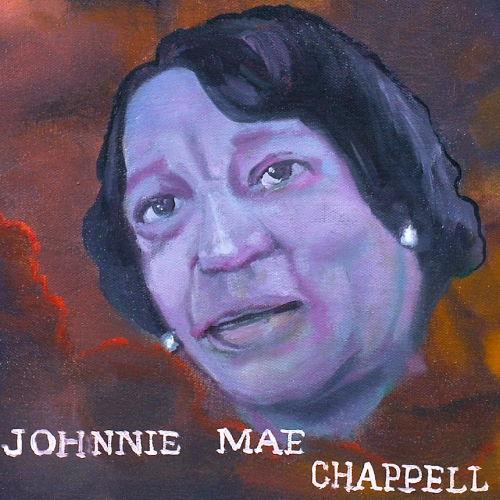Jim Crow Museum
1010 Campus Drive
Big Rapids, MI 49307
[email protected]
(231) 591-5873

On March 23, 1964, race riots raged in downtown Jacksonville, Florida. Johnnie Mae Chappell, a 35-year-old wife and mother of 10 children, was not anywhere near downtown that evening, though. Instead, she was frantically searching the roadside near her home in Pickettville, the poor all-black neighborhood in the Jacksonville area, with two neighbors, hoping to find the wallet she had lost on her way home (Hastings, 2003). Unfortunately, Chappell would lose her life to senseless violence that night simply because of the color of her skin.
While Chappell and her neighbors were searching the edge of the road with a flashlight, a car carrying four white men approached. The men, who had been incensed by radio reports about the riots, were driving around looking to "get" a black person. When they saw three black individuals on the side of the road, the man seated in the front passenger seat pulled up a gun and fired. Chappell was struck in the stomach by a single bullet and died on the way to the hospital (Hastings, 2003).
As was the case with the killing of many African Americans during the Jim Crow era, Chappell's murder received very little attention. The local media mentioned her death only as a side note in stories about the riots that focused mainly on white citizens who had been injured (Murphy, 2005). Also, according to the detectives who eventually investigated and solved Chappell's murder, nobody within the local police force had ever been assigned to investigate the crime. Instead, detectives Lee Cody and Donald Coleman cracked the case somewhat by chance (Hastings, 2003).
In August 1964, five months after the murder, Cody and Coleman were approached on two separate occasions by a young man named Wayne Chessman, who said he wanted to help the detectives. The detectives were initially unsure what Chessman was talking about, but after seeing Chessman leave their second encounter in a car that matched the one that carried Chappell's murderer, the detectives decided to question Chessman at the police station. During the subsequent interview, Chessman provided a detailed account of Chappell's murder and implicated 3 other men: Elmer Kato, the driver of the car, James Alex Davis, who sat in the back seat with Chessman that night, and J.W. Rich, the shooter (Hastings, 2003). Under questioning, Kato and Rich confessed to the crime, although Rich claimed that it was an accident (Mitchell, 2010).
After Cody and Coleman completed their investigation, Chessman, Kato, Rich, and Davis were arrested and charged with first-degree murder. However, the threads of justice began to unravel at that point. The two detectives claim that they were berated by their commanding officer for investigating the crime, and they were subsequently removed from the case. Additionally, the murder weapon mysteriously disappeared. Despite the loss of evidence, the state proceeded with its case, and an all-white jury found Rich guilty of a lesser charge of manslaughter. This was a surprising result, given that many white people avoided any punishment for killing black men, women, and children throughout the Jim Crow era. Rich was sentenced to ten years in prison as a result of his conviction, but he only served three years before being released. All charges against the other three men were dropped (Hastings, 2003).
While her killers went largely unpunished for their crime, Chappell's family was torn apart following her death. The eldest five children, all daughters from Chappell's first marriage, were sent to live with various relatives on their father's side of the family. Authorities removed the five youngest children, all boys, from their father Willie's care and split them up among foster families. For over 30 years, the children had very little information about what had really happened to their mother. On the 32nd anniversary of her death, Chappell's children finally heard the story of what happened to their mother when Cody approached them at a family reunion (Hastings, 2003).
Cody and Coleman also had their lives permanently altered by the Chappell case. The detectives claim that their pursuance of the truth caused them to be demoted and, shortly thereafter, fired for insubordination. Neither man ever worked in law enforcement again, but neither ever forgot the Chappell case (Murphy, 2005).
Although the state provided little justice in the murder of Johnnie Mae Chappell, she will not be one of the forgotten or unknown. Chappell's name was added to the Civil Rights Memorial in Montgomery, Alabama, in 2000 (Mitchell, 2010). Also, in 2005, the Florida legislature honored Chappell by renaming a section of the highway where she was murdered the "Johnnie Mae Chappell Parkway" (Murphy, 2005). The memory of Chappell serves as a powerful reminder of the hatred and brutal violence that robbed so many individuals of their lives solely because of their race.
Neil Baumgartner
Staff Docent
Jim Crow Museum
November 2012
References
Hastings, D. (2003, December 1). Johnnie Mae Chappell: Long road to truth. The Associated
Press.
Retrieved from http://injusticebusters.org/2003/Chappell_Jacksonville.htm.
Mitchell, J. (2010, November 18). Former detective says 1964 murder can be prosecuted
[Journey to Justice].
Retrieved from http://blogs.clarionledger.com/jmitchell/tag/johnnie-mae-chappell/.
Murphy, D. (2005, September 7). Seeking justice for a racial killing, 40 years later:
The Johnnie Mae Chappell case could become the latest in a wave of the South's "atonement
trials". Dateline NBC on Dateline. Retrieved from http://www.msnbc.msn.com/id/8670054/ns/dateline_nbc/t/seeking-justice-racial-killing-years-later/.
Johnnie Mae Chappell Video